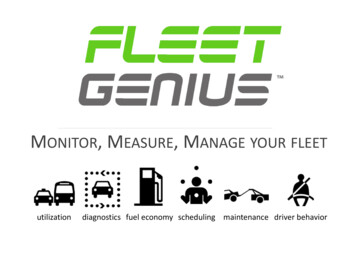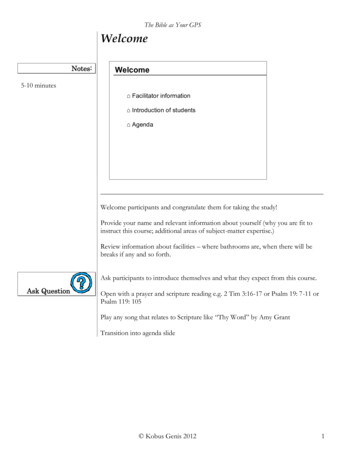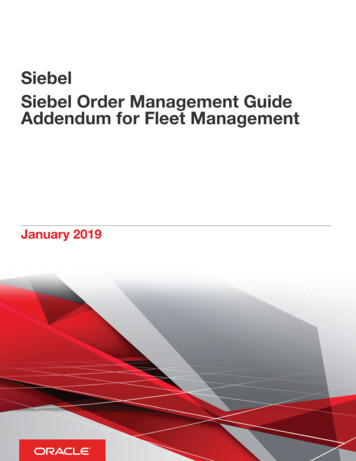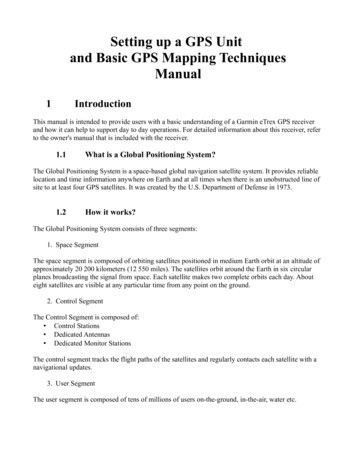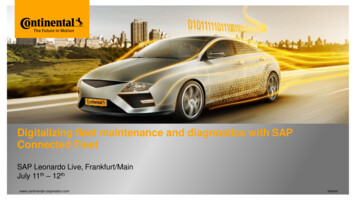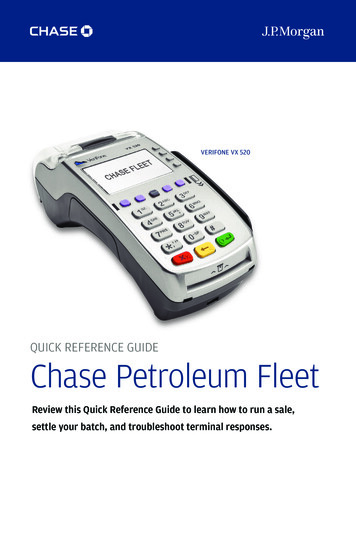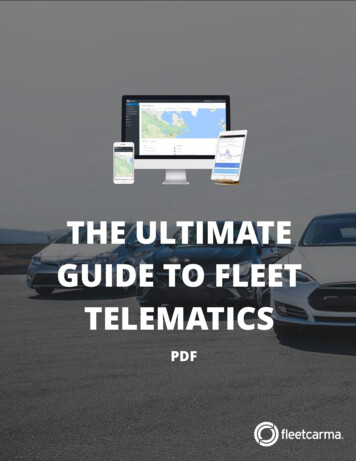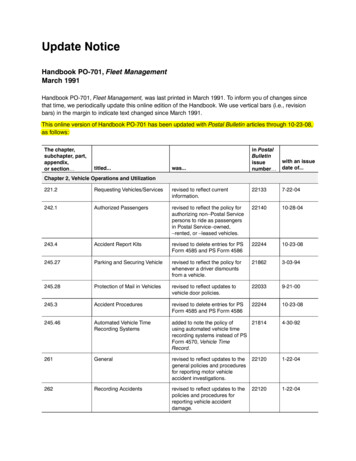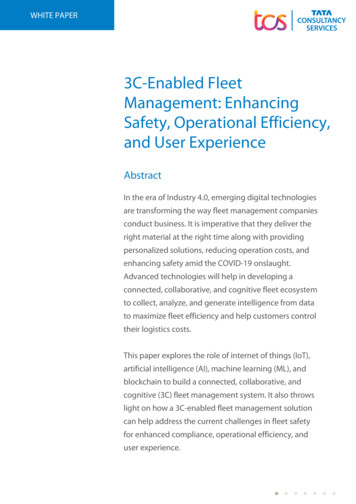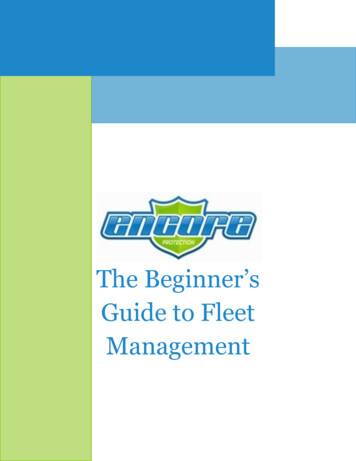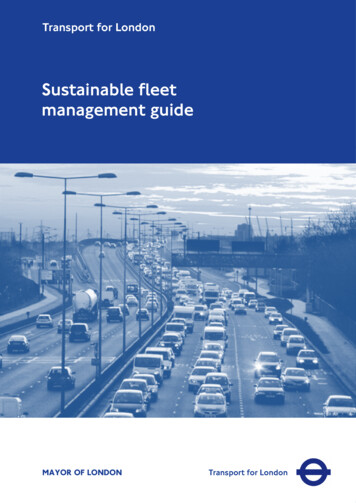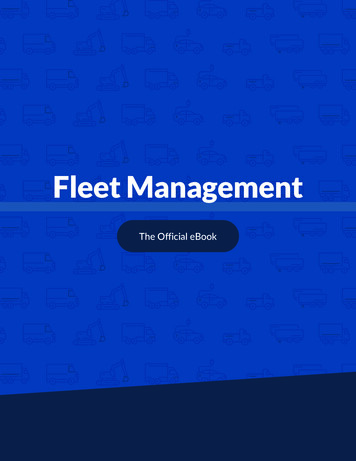
Transcription
Fleet ManagementThe Official eBook
INTRONo product sells itself.Even the very best products and services need skilled salespeoplebecause not every customer knows what problems they can solve.They might not even realize other organizations have the samechallenges, or that there are products that can address their needs.Partners like you are the key to enlightening potential customers.We have collected some of our best content to create a short eBookthat will help you show clients how fleet management solutions willmake them more profitable. And there’s more to fleet managementthan profit. With fleet management solutions, you can also help themmeet sustainability goals, get more work from their vehicles, andemphasize safety.This content covers a wide range of information that can help yousolve operational challenges related to accountability, compliance,efficiency, and safety for your clients. If there’s anything else we cando to equip you for sales success, please feel free to contact us.
CONTENTS03How GPS Tracking Can Grow Your Business06GPS Tracking and Vehicle Maintenance07Five Top Uses of GPS Tracking09How You Can Waste Less Fuel With GPS Software11How to Pitch GPS Software to Upper Management12The Top Questions About Trailer Tracking13Smart Cameras Versus Consumer Dash Cams15Trio Forest Achieves an Overnight Fleet Safety Turnaround18GPS Tracking Leads to 1.4 Million Boost
How GPS Tracking Can Grow Your BusinessGPS technology is everywhere. Take a close look at thevehicles around you during your next drive. Notice thedelivery trucks, pest control trucks, government vehicles,construction trucks, big rigs, and numerous other logoedvehicles?More than 50% of them are equipped with GPS tracking.There’s a reason so many businesses use it. It increasestheir bottom line by cutting costs and enhancingcustomer satisfaction. That means huge potential forbusiness growth.We have some concrete examples to show how thisworks for organizations of all sizes. In a recent survey,businesses shared their experiences with using GPStechnology to manage their fleets.Participants voted fuel cost and consumption as thebiggest challenges to their businesses. Second place is athree-way tie.There’s a solution to every one of thesechallenges: GPS-based vehicle management software.Also, many of these answers link to each other.Providing data that makes drivers slow down keepsthem safer. It reduces fuel consumption. And slowingdown reduces wear-and-tear on vehicles.03“The more data you have, the better off you are,” saidJoshua Foster, executive director of Zap Termite andPest Control in Sacramento, Calif.Businesses can use data to address accountability,compliance, efficiency, and safety. GPS technology canreveal problems that you haven’t noticed before. And itcan turn these weaknesses into strengths.Top Technician &Vehicle Challenges
Only 2% of the survey participantsare unlikely to recommend GPS toother organizations. The remaining98% said GPS technology gave thema quick ROI. Some found that GPStracking is integral to their success.Overwhelming Thumbs-Up for GPS Technology“It’s something I wouldn’t gowithout,” said Jimmy Arnold ofGeorgia-based Peachtree PestControl.Of course, the technology itselfisn’t the only key. In this chart, theresponses show that customersneed to be happy with the companyproviding their GPS tracking. Theywant quality support for softwareand hardware.Some technicians and drivers view GPS technology as Big Brother — at first. But the surveyresponses show that it’s possible to get their buy-in. The key is how organizations implementGPS. Two-thirds of those surveyed made a special effort to outline the benefits.Businesses that do more to show the benefits get more employee support.“Like anything else, you don’tEmployees Weigh Inwant to just hammer the guyswho aren’t performing,” saidDavid Cooksey of McCallService. “You want to rewardthe guys who are performing.”One piece of advice we hearfrequently is to use GPS trackingto help employees. If their firstinteraction with the technologyis a reprimand, it sets the stagefor a confrontation betweenmanagement and drivers. On theother hand, using it to rewardgood driving sets a positiveprecedent. And that could pavethe way for a smoother buy-in.04
No organization is too small for GPS tracking. Even witha small fleet, you’ll gain insights into vehicle use. You’lltrack maintenance more effectively. And you will beable to do more work with the same number of people,in the same amount of time. That’s exactly what a smallorganization needs.The 53% of organizations that don’t use GPS tracking sayit’s because they’re too small. Yet 39% of respondentshad fleets of 2-4 vehicles. Only 12% percent had morethan 25 vehicles. That means GPS tracking is scalable.Efficiency and maintenance are also critical to smallerbusinesses. GPS can address both issues and enhancecustomer service. Customers will get proof of serviceand more-accurate ETAs.Customer reviews are essential to businesses, so that’s ahuge potential boost for smaller organizations.On the other end of the spectrum, a large organizationcan use GPS technology to make sure no customers getlost. It’s easy to overlook a small percentage when youoperate on a larger scale, but it’s not good for ensuringrepeat business.“I think it’s a good tool to use whether you’re a small fleetor whether you’re a large fleet, “said Scott Davis of PestPro Pest Control, which has two service vans. “We allhave those risk exposures, no matter who you are.Does Every Organization Need GPS Technology?05
How GPS Tracking Benefits Your Vehicle HealthHave you ever considered how GPS tracking benefitsthe health of your vehicles? Making sure you know eachvehicle’s last oil change, tire rotation, smog check, brakeinspection, transmission flush, etc. can help you get morefrom them.Even well-organized businesses overlook one – or evenmore – of these at one time or another, though. GPStracking can help you manage your vehicle maintenanceand reduce the odds of breakdowns.Improved Maintenance SchedulingOne of the most-important GPS tracking benefits is theability to run a cleaner and healthier fleet.The maintenance scheduling module allows fleetmanagers or maintenance managers to easily trackmaintenance services.By using the maintenance scheduling module, you’llreceive a reminder when service is upcoming or due. Youcan also run a report to see an overview of upcoming oroverdue maintenance.An In-Depth Fleet Utilization ReportYou can also increase the lifespan of your vehicles bybalancing how often you use them. Tracking softwareoffers insights into how frequently your vehicles areon the road so you make adjustments to distribute theworkload.A fleet utilization report can give you information suchas how many trips have been made, days utilized, enginehours, distance, and even which employees are drivingthe vehicles.These are just a few examples of how GPS trackingmakes fleet management easier for you.Get GPS Tracking Benefits for Your FleetMaintenance scheduling, automated reminders, andoverview reports are proactive ways of keeping yourvehicles in prime condition. That means getting morework done and making your customers happy.Using a maintenance feature within fleet software willhelp prevent breakdowns. These breakdowns lead to lostbusiness, time wasted getting vehicles fixed, and payingyour techs for unproductive time.06
Top 5 Most-Common GPS Tracking Alertsfrom Our CustomersIt’s possible to get GPS tracking alerts for a wide varietyof driver actions. But which ones rise to the top withusers?We’ve taken user data from one GPS provider to seewhat trends we see with customers. The results are a Top5 list of real-world GPS data applications.Each of these alerts is a great choice for meeting safetyand efficiency goals. Together, they provide a solid set ofdata that can upgrade your fleet management efforts.Odd-Hours Alert: 48%Nearly half of the alerts our customers receive arefor the Odd-Hours Tracking Alert. This can tip fleetmanagers off to unauthorized use of company vehicles. Ifyour company allows drivers to take their fleet vehicleshome, they might be using them for side jobs or even justrunning errands with them.Either way, that can cost your organization money byburning fuel and increasing wear and tear. That can evenimpact your vehicle life cycles and procurement plans.07
Speeding Alert75 MPH : 15%Speeding can have bigrepercussions for yourorganization. It can increaseinsurance rates (no insurancecompany likes speeding tickets)and tarnish your brand name.Plus, speed is a factor for manyaccidents.And driving more than 75 mphis a sure way to decrease yourvehicles’ gas mileage. Mostvehicles are designed to be theirmost-efficient at around 55 mph.Plus, only interstate highwayshave speed limits of 75 mph. Ifyour drivers are going that fast,there’s a good chance they’redoing so on roadways with farlower speed limits. The SpeedingAlert is a great way to discoverbad driving habits.Landmark Alert: 7%Our customers often createlandmarks using our softwaresolutions. You can use landmarksfor customer locations, depots, oreven drivers’ homes.The Landmark GPS TrackingAlert provides great insightsfor fleet managers, and they’recustomizable to every fleet’sneeds. And it’s an effectivemethod for ensuring that yourdrivers are using vehicles for theright purposes.Diagnostic Trouble Code(DTC) Alert: 6%The Diagnostic Trouble CodesAlert can tip fleet managers off tomaintenance issues and even fuelusage.This alert can even help driversand fleet managers determine ifthe trouble code is a minor issuethat can be handled later, or anemergency that requires them topull over immediately.The fuel usage function is evenmore accurate when paired with afuel card integration.Posted Speed LimitAlert: 4%It’s possible to configurethe Posted Speed Limit GPSTracking Alert to let you knowwhen drivers exceed the speedlimit by a certain threshold. Thatcan be the speed limit itself. Oryou can give them some leeway– maybe six miles per hour abovethe posted limit, for example.Also, you can have the system tellthe driver to slow down.08
How Fleet Software Can Reduce Fuel UseAdding up to 90 billion in 2016, diesel fuel is thesecond biggest cost for fleets, after drivers themselves.It’s also the easiest cost to trim, thanks to a handful ofinefficiencies that cost commercial motor vehicles inthe US billions in waste every year. Fortunately, fleetsoftware can reduce fuel use. Before we get into thesolution, let’s check out some of the habits that aremaking your fleet waste fuel – and how much that cancost you.Annual fuel use averages will depend on the type ofvehicle. At 11,242 gasoline gallon equivalent (GGE),transit buses average the most fuel used per year, closelyfollowed by Class 8 trucks at a yearly average of 10,739GGE, according to U.S. Department of Energy data.So, what exactly contributes to higher fuel costs? Andhow much wasted fuel can a fleet manager realisticallycut down on, to reduce their overall fleet managementcosts? These are the top ways trucks will waste fuel –andmoney– in 2020 and beyond.SpeedingAccording to the American Trucking Associations (ATA),a commercial truck driving at 75 mph uses up 27% morefuel than one traveling at 65 mph, thanks to strongerwind resistance. The cost of this extra fuel burn adds up09fast – much faster than any saving a truck might make bydriving at a higher speed. For example, over a distance of50 miles, that 10mph increase from 65 mph to 75 mphwill only save a driver 6 minutes and 9 seconds.A fleet that wants to save fuel can choose to monitorits drivers’ speeding habits through fleet managementsoftware (FMS) with GPS tracking. Of course, fast speedscan be unavoidable when following the flow of traffic, butfiguring out a healthy target speed can still account forthe majority of that 27% in fuel savings.Harsh Braking/AcceleratingAfter speeding, the next biggest fuel waster is stop-andgo braking and accelerating. Once again, this fuel wasteisn’t entirely avoidable, as both traffic congestion andhilly regions will naturally have drivers’ feet reachingfor the brake more often. However, researchers atthe Department of Energy’s Oak Ridge NationalLaboratory estimate the impact of harsh driving on fueleconomy to be between 15% and 30%.Harsh driving can be tracked with the accelerometerin an FMS hardware unit. Using cruise control (whenpossible) can also cut down on excessive starts and stops.
IdlingWhile excessive idling isn’t as bad as speeding or harshbraking, it still wastes gas to the tune of betweena quarter and a half-gallon per hour, depending onengine size and A/C use. The solution is easy: Shut offyour engine when your vehicle isn’t in motion. Startingthe engine only uses 10 seconds’ worth of fuel, asthe Argonne National Laboratory found in 2015.In other words, if your vehicle won’t be moving withinthe next ten seconds, you’ll cut fuel use by turning it off.The practice can boost fuel economy by 4–5%, one guidefrom the Department of Energy notes.Once again, an FMS can track idling times, lettingmanagers know when their fleet might be able to cutback.The Numbers Are In: Fleet SoftwareReduces Fuel UseWithout the savings an FMS has to offer, the averageClass 8 Truck costs 27,491.84 to fuel up over thecourse of a year. By simply accounting for the topthree biggest fuel wasters (speeding, idling, and harshbraking/accelerating), that same truck’s fuel only costs 19,244.29 across an entire year — saving a fleet ofthem almost 8,250 per vehicle. For a fleet of 50 trucks,that adds up to an annual wastage – or savings – ofover 412,000 on fuel alone. That’s a huge return oninvestment that shows how fleet software can reducefuel usage. As you can see, if used properly, a fleetmanagement system can pay for itself many times over,in terms of the fuel saved – all while improving securityand operational efficiency.How to Reduce Fuel Use in Your FleetMore Benefits of Fleet SoftwareThere are many other ways to improve a vehicle’smiles per gallon, from changing the weight of cargo toA/C use to proper tire inflation. However, the EPA hasidentified the three issues listed above as the biggestneedle-movers for avoiding excess fuel use.One of the biggest benefits of fleet software is how itcan help employees. It can exonerate them from trafficviolations, prove that they got their work done, and cutdown dramatically on their paperwork. Those are just afew of the benefits organizations notice when switchingto fleet software.It’s difficult to put a hard number on the amount of fuelany given vehicle could avoid using in a year. Factors likethe ratio of highway driving to stop-and-go traffic canbe tough to estimate, while regional topography can’t beavoided.However, by combining the varying ways a fleetmanagement system can improve its fuel efficiency –including the three main methods outlined above – theaverage vehicle can reduce fuel waste by a minimumof 10%, and by as much as 30% in a given year.Here’s what that percentage looks like as potentialannual cost savings for eight different types of vehicle,given their average annual fuel use in GGEs (andassuming a national average gas price of 2.56 pergallon).Or, to put it another way, this is how much each type ofvehicle will waste in 2020, on unnecessary fuel, by notusing an FMS.Organizations can also safeguard their brand usingfleet software. Think of every vehicle in your fleet as abillboard that advertises your organization to the entirecommunity. Without a fleet management solution, yourcommunity could conclude that you don’t care abouthow your drivers behave on the roads and the effect onthe general public. And imagine if they see one of yourvehicles involved in a crash.On the other hand, drivers that have the benefitof coaching and actionable feedback can put yourorganization’s best foot forward. And then there’spollution, but how can you get cleaner and greener ifyou don’t have fuel use data? With fleet managementsystems in place, you’ll be able to identify steps that willuse less fuel and lower your carbon footprint.Besides lowering your speeds, there’s also reduced idletimes and more-efficient route planning. With moreand more consumers preferring to do business withcompanies that commit to sustainability, this is a greataspect of fleet management software.10
How to Pitch GPS Software to Upper ManagementGPS tracking software solves many challenges, fromdriver accountability to improving efficiencies and safety.If you believe tracking software can help solve yourchallenges, here’s how to get buy-in.Identify How GPS Tracking Can Solve YourChallengesThe first step to making the business case for anysolution is identifying the problems. Depending on thesize of your organization, upper management may noteven be aware of every day or long-standing issueswithin the fleet. This is your chance to bring them to lightand provide a solution.It’s important to lay out how your fleet needs to improveand how GPS software will help achieve your goals. It iseasier to get buy-in from upper management when thereis a clear objective, such as a new safety initiative to helpreduce the number of accidents.Test-Driving a GPS Tracking SolutionOne of the easiest ways to receive buy-in is testing it onyour fleet. Some providers offer pilot programs wherethey install devices on a select few vehicles and assetswithin your fleet to gather benchmark data for you to11see the proof of the technology and that it is the answerto help overcome your challenges. It’s also an excellentchance to test out and see if the GPS tracking providercan do what they say they can.Most importantly, it’s crucial to share the data withupper management and other departments that will beaffected. Getting a benchmark of data at the beginningto reflect current performance will provide evidence thatthere are problems that need solving.During the pilot, you can put the GPS tracking softwareto work addressing these challenges.Proposing a GPS Tracking SolutionAt the end of your pilot, you will have the data youneed to demonstrate how GPS software can solvethese issues. Providing this to upper management willbe vital to receiving their buy-in to move forward withpurchasing a solution.Also, presenting the expected return on investment(ROI) can help positively position the purchase fromtheir perspective. Showing how you can hold driversmore accountable, increase efficiencies, and provide asafer work environment will be all you need to receivebuy-in to implement GPS software.
The Top Questions About Trailer TrackingThe trailer tracker might be themost-overlooked tool in fleetmanagement. Many organizationsfocus on their vehicles, which isa great first step, but trailers andtheir contents are also valuablecomponents of your business.networks. This allows them toprovide information includingreal-time and historic locationand time spent for drop-offs andpickups. This data can ensure thatdrivers don’t make unauthorizedstops or detours with trailers.Why would I want totrack my trailers?Depending on the refresh ratesetting of the installed trailertracking device, a manual ping willgive you the approximate locationof a trailer. Typically, refresh ratesupdate at intervals of a few timesper day, or even once daily. Somecan also be motion based. This alsodepends on the type of device.It’s easy to say “trailers can’t goanywhere by themselves, so whytrack them?” But trailers are oftenstolen. Using GPS allows youto check their locations, verifydrops/pickups, and much more.And the solar-powered trailertrackers won’t even increase yourcarbon footprint or cost moremoney to power. In short, a trailertracker addresses accountability,compliance, safety, and efficiency.How does a trailer trackerwork to verify location,drops, and pickups?Trailer tracking devices use GPSand cell networks or satelliteCan I use GPS to locatemy lost or stolen trailers?Trailer tracking can locate lost orstolen trailers as well as pinpointthe location of trailers incorrectlyparked. A trailer tracker can evenhelp identify illegal behavior thatcould result in lost trailers orvehicles, wrecks, and stolen goods.Can I see which trailersare used the most/least?Utilization reports show detailsof how much you are using yourtrailers. Filtering by unutilizedtrailers, daily utilization, miles, andtrips provides insight into whichtrailers your organization usesmost and least often.How can I use a trailertracker for maintainingmy trailers?A powered GPS tracking solutionallows you to stay on top ofpreventative maintenance forall your operation’s vehicles,trailers, and other mobile assets.By creating a schedule and settingreminders, you can automaticallyalert your maintenance teamwhen a trailer’s maintenance dateis approaching, due, or overdue.And with fleet maintenancereports, you can make sure trailersreceive the maintenance theyneed.12
Should I Get a Dashcam from Amazon?Right now, many people are asking if they should get adashcam online. Our answer? It depends.preventing accidents from happening in the first place.They give drivers and managers more actionableinformation about driving habits — some cameras canIf you want a dashcam for your personal vehicle,ordering one from Amazon or your favoriteonline store might be perfect. But if you want realinsights for a business with a fleet of vehicles, nomere dash cam will deliver.Dash Cam vs. Smart Fleet CameraA dashcam is great for reactive situations: Yourdriver gets in an accident. You want evidence tofind out what happened. That’s a perfect use casefor a dashcam.They are also excellent for capturing hard stops,hard accelerations, and other high-G events.If your organization would rather preventaccidents and coach its drivers, you need anoption beyond the basic dashcam. That’s wheresmart fleet cameras come in. The features thatseparate these from a dashcam are multiple cameras,driver scoring, and artificial intelligence.More important than the features, though, are how youcan use an in-cab fleet camera. They’re really for13even detect signs of distracted driving. This enhancedawareness can help them make decisions that avoiddangerous situations.And they also help fleet managers put everything thathappens in the cab into context.
What Do You Mean “In Context?”Let’s say your telematics device detects a hardacceleration, a sudden stop or even a high G-force eventlike a hard turn?Without any information, that can make your driver lookbad. But what if that data is the result of actions yourdriver took to avoid a collision? An AI-equipped in-cabcamera will see that as a positive event and give you thedata to stand by your drivers for their quick thinking andtheir skills.It automatically saves a segment whenever there’s a“triggering event” like hard braking or running a red light.The AI processor analyzes what’s happening, and itknows when to save a segment. You can also use a mobileapp to access videos on the go, in real time. The cameraitself stores 100 hours of data locally.Views and Information to Suit Your NeedsYou can select a number of views from in-cab cameras.They can give you a full 360 view, a straight-aheadview, side views, driver-facing views, or anycombination necessary.This flexibility gives you the informationyou need to make your fleet safer. Youcan tell if your drivers are focused on theroad, whether another driver’s actionsprompted them, and even how carefullythey’re following speed limits and roadconditions.A simple dashcam won’t be able to matchthe proactive approach of an in-cabfleet camera – from U-turn detection tospeeding violations tofollowing distance.This can help your organization identify and build ongood drivers. They can model best practices fleetwide.That’s good for your organization, your drivers, and yourcustomers.No Pouring Over FootageWrapping Up the Dash Cam QuestionYes, you can buy a simple dashcam from any onlineretailer. But here’s the real question: What’s your goal,a fleet that looks like it’s trying to be safer or a fleetthat really is committed to safety? If you’re in it for realimprovement, you need more than a dashcam.With a dashcam, you’ll have to comb through hoursof footage to find relevant events. An AI-equippedcamera saves you from that time-wasting exercise:14
Trio Forest Achieves an Overnight FleetSafety TurnaroundAll drivers have their ingrained habits. It’s easy for us toignore or justify them: “I slowed down enough for thatstop sign. Everybody drives 10 miles per hour over thespeed limit. It’s just one text message!”Those tendencies seem trivial. But they add up tosignificant risks.Searching for a Safety SolutionThe management team at Trio Forest Products startedresearching ways to safeguard itself from the cost ofaccidents: A fatality can cost a company 3.6 million if it’sfound at fault. The average cost of an injury accident is 200,000.15Trio Forest has relied on GPS tracking and complianceproducts since 2010. The results they gained and trustthey established with their GPS account manager ledthem to select the Driveri smart camera.a major shift, and drivers across many industries viewthem with suspicion.Drivers knew the cameras were coming. Two driverswere close to resigning, believing the company’s culturewould take a dystopian “Big Brother” turn. Barry Ruchty,inventory manager at Trio Forest Products, knew he hada challenge on his hands. In-cab cameras representedBecause his position also encompasses co-managingthe fleet and its drivers, Ruchty needed to assure themthat the Driveri cameras would function as a wingman,not a watchdog. To make that happen, he implementedpractices from his former career.
Creating a BaselineFocusing on the FactsRuchty came to Trio Forest Products after 32 yearsin law enforcement. He trained officers and deputies,showing them that safety is even more important forpeople who wear a badge.With two days of data in hand, Ruchty held talks witheach driver individually. His message?Since joining Trio Forest, he worked his way fromdriving a truck to management. With knowledge rangingfrom law enforcement to earning his commercialdriver’s license, Ruchty had his team’s confidence. Heunderstands their world, and they know it.Ruchty adapted a method he used to trained young lawenforcement officers to emphasize safety over speed inresponding to emergency calls. He monitored drivers fortwo days and let the Driveri GreenZone system scorethem; GreenZone is a driver scorecard that recordsboth good habits and safety incidents.Trio Forest Products drivers carried on as always in thedays after the camera installation. There were no bigannouncements and no dire warnings. The results camein: The drivers all scored in the 600-point range out of apossible 1,000. Many Driveri users select a score of 900as their benchmark.“I about fell over,” Ruchty said. “I wascompletely shocked by how bad it was.”Ruchty noticed a wide spectrum of violations thatresulted in the low scores.“Let me introduce you to yourself,” Ruchtytold them.He emphasized a few key points withthe drivers:How they drive at work is also howthey drive with their families.He doesn’t have time or interest inmonitoring them constantly.The only time he would watch them is ifDriveri indicated a safety event.Ruchty says no manager has time to idly peer in ondrivers without a reason. He only reviews footage whenDriveri notifies him about a possible violation.He emphasized this to drivers from thestart: “I will only see what’s created byyou.”Example Driveri Alerts16
Drivers Improve OvernightStill Getting the Job Done on TimeThe day after drivers met with Ruchty, Driveri scoresshot into the 900s fleet wide. Even better, they’ve stayedthere. The lowest score on a recent day was 931 out of1,000.There’s always a rush to get a job done. Does easing offthe gas a bit make it harder to meet deadlines?The GreenZone scores represent a 91-percentreduction in drivers triggering safety events. In the firstweek of use, they triggered 102 events. In the first weekof March 2020, they triggered nine events.Ruchty said Trio Forest drivers are making the samenumber of deliveries, even while coming to a completestop and driving slower.With most routes in the 15-25 mile range, the timedrivers can save by speeding just doesn’t help, he added.And with the longer runs, there’s still no way to get inextra jobs.Slowing down, though, pays dividends beyond thenumber of jobs. Ruchty listed improved gas mileage andless wear on brakes as additional benefits.The success with Driveri camera may help with insurancecosts in the future, too.“Our insurance carrier is absolutely inlove with this system,” Ruchty said.GreenZone scores at Trio Forest have remainedconsistent because of the constant reminders the systemprovides to drivers and managers. Improving old drivinghabits remains top of mind.Ruchty will sometimes call a driver when he receives asafety event, just to let them know that safety is a neverending goal. In short, Driveri is an outstanding success.He also believes it would help any other fleet managerwho truly cares about safety.Some drivers even exceed the maximum 1,000-pointscore with courteous, safe driving actions like slowingdown to let others merge. These actions earn DriverStars that boost their scores.Trio Forest Products also has a reward system: Thedriver with the highest average score each monthreceives a gift card. Ruchty believes rewards are moreeffective than reprimands.17“It’s something I would push onanyone,” he said.
GPS Tracking Leads to 1.4 Million BoostEvery moment that a truck is sitting in a yard is a momentit’s not making money. Even worse, that’s a moment thatmakes a customer think “where’s my delivery?”Alexander Lumber wanted to reduce the time it takes toturn a truck – to have an empty truck return to the yard,get re-loaded, and get back in action. To accomplish this,they use GPS fleet tracking tec
data that can upgrade your fleet management efforts. Odd-Hours Alert: 48% Nearly half of the alerts our customers receive are for the Odd-Hours Tracking Alert. This can tip fleet managers off to unauthorized use of company vehicles. If your company allows drivers to take their fleet vehicles
